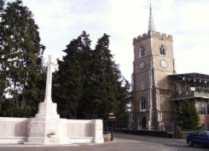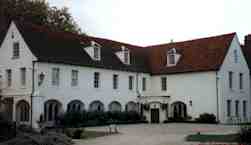Ware
HISTORY

According to archaeologists Ware is one of the oldest occupied places in Europe. This century, excavations close to Ware Lock revealed settlements dating as far back as the Middle Stone Age, around 5,000 to 10,000 years ago. The explanation for Ware's early occupancy is that Ware was positioned at the point where one of the country's oldest roadways crossed the River Lea. The road originally known as Ermine Street and later as the Old North Road which was the main road of Medieval England.
The road was widened when the Romans conquered England for military purposes and it is thought the original town of Ware was then built alongside the road. Archaeologists have found large amounts of building remains, a Roman slave shackle along with buildings that could of housed slave factory workers and artefacts on the site suggesting even then the area used was of a substantial size. However it is for the period after the Romans and during the Anglo-Saxon period that Ware is really recognised in history.
The Saxons established Kingdoms in the area that were then invaded by the Danes until only 'Wessex' remained. In the year 886AD the 'Peace of Wedmore' distinguished the frontier between Wessex and Danelaw and the River Lea formed part of the frontier and therefore Ware became a frontier town.
King Alfred later diverted the course of the River Lea to prevent the Danes rowing their boats up river and it's believed the Ware's Saxon name 'Waras' derives from the weirs built by Alfred to divert the river.
It was the Normans who conquered the area and a new bridge was built across the Lea. By the end of the 12th century Ware had grown into the town we recognise today. Royal Charters for a market and a fair were granted and points were made for collecting tolls from all ships sailing to London on the Lea and from all vehicles crossing the new bridge. This was a result of a visit by Henry III giving the town official recognition.
Industry
Ware was always well situated due to its positioning on the River Lea but as time progressed and roads were built Ware became even more of an important town in terms of passing trade. A number of inns were opened to cope and benefit from travellers these included the Bull, Saracen's Head, the White Hart and the Crown.
From the 17th century until 1994 Ware became the premier malting town in England when the last malting house, St. Paul's was closed in 1994. This brought an end to an industry that had made Ware famous for over 500 years.
Ware - 'Grannery of London'
Ware - the name is derived from "Weare" or Dam - is where the old roman road Ermine Street crossed the river Lea. During the 9th century Ware was on the border between Saxon England and the invading Danes, who in 895AD sailed up the Lea from the Thames. They are thought to have marched on foot from here, after King Alfred's men altered the flow of the river, stranding their ships at Ware. For many centuries the main trade was milling and malting, for which barley from East Anglia was processed, then transported by river down to London. During the plague of 1665 Ware bargemen risked their lives to continue supplying the city with grain, for which they received certain privileges from King Charles II. By 1788 Ware had 22 maltings and became known as the 'Grannery of London'. The last maltings closed down during the 1990's, although some of the old buildings remain, now converted into riverside flats or offices. A statue was erected in 1999 to act as a reminder of Ware's past: "The Maltmaker" by Jill Tweed is at the north end of the high street. The only remains of an industry that once dominated the region are the surviving maltings at Stanstead Abbotts to the south.
A friary was founded at Ware around 1338. After the dissolution of the monastries it was bought by Thomas Byrche in 1544 and converted into a private house. During the first world war it served as a military hospital and was given to the town in 1920. Today, Ware Priory is a Grade I listed building and houses the Town Council.
Part of the nearby Church of St. Mary also dates from around 1338, when it was rebuilt by Joan the Fair Maid of Kent (and wife of The Black Prince), although there had been an earlier church here since about 1078. Additions made during the following two centuries created much of the building that exists today.
